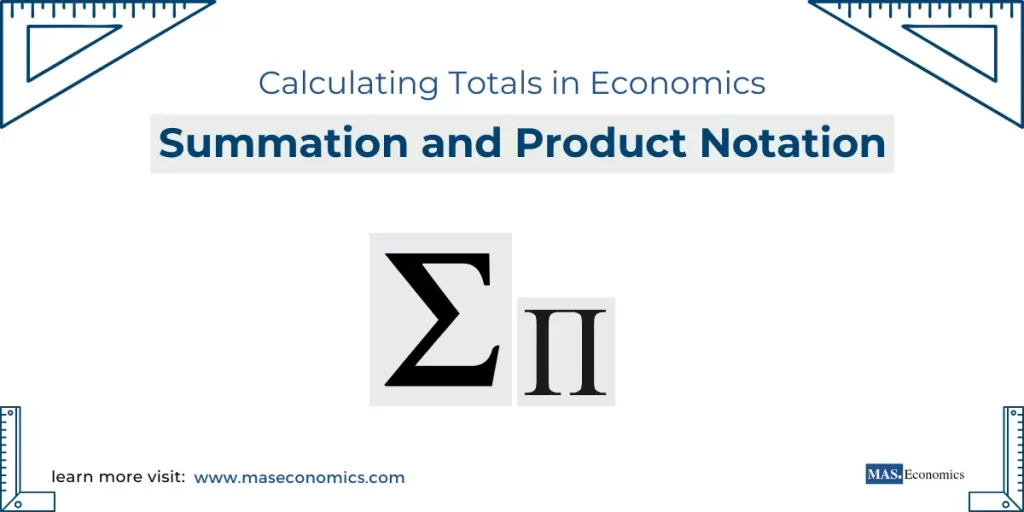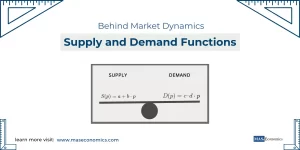In economics, understanding the broader trends often requires aggregating data from many sources. Whether we are calculating total output, determining cumulative utility, or computing national income, there is often a need to add or multiply various quantities. This is where summation and product notations come in handy.
Summation and product notations are mathematical tools that help us efficiently express the addition and multiplication of sequences of numbers or variables. These notations not only simplify complex calculations but also make them easier to understand and interpret.
Understanding Summation Notation
What is Summation Notation?
Summation notation, represented by the symbol \(\Sigma\), allows us to succinctly represent the sum of a sequence of terms. Instead of writing out each term individually, we use \(\Sigma\) to indicate that a set of terms should be added together. This notation is especially useful in economics, where adding multiple components, such as income from different sectors or expenditures, is common.
For instance, consider calculating the gross domestic product (GDP) by summing the output of multiple sectors in the economy. The total GDP (\(Y\)) can be represented as:
In which:
- \(Y_i\) represents the output of the \(i^{th}\) sector.
- \(n\) is the total number of sectors.
In this form, summation notation makes it easy to represent the entire economy’s production as the sum of the outputs from each sector, providing a clear and concise view of the total economic activity.
Practical Example: Summation in Utility Analysis
Summation notation is also crucial when analyzing consumer behavior. Total utility is derived from summing the utility that a consumer receives from consuming different quantities of a good or multiple goods. If a consumer derives utility \(U_i\) from consuming the \(i^{th}\) good, then the total utility \(U_{total}\) is expressed as:
Here:
- \(U_i\) represents the utility derived from the \(i^{th}\) unit of consumption.
- \(n\) is the total number of units consumed.
This notation allows economists to simplify the process of evaluating the satisfaction levels that consumers derive from their consumption choices, providing insights into consumer demand and preferences.
Properties of Summation
Summation notation follows several properties that make it easier to handle arithmetic operations:
-
Linearity: The sum of the sum is equal to the sum of each element. For any constants \(a\) and \(b\), and any sequences \(x_i\) and \(y_i\):
\[ \sum_{i=1}^{n} \left( a \cdot x_i + b \cdot y_i \right) = a \sum_{i=1}^{n} x_i + b \sum_{i=1}^{n} y_i \]
-
Additivity: If we want to sum from \(i = m\) to \(n\), we can split the sum into two parts:
\[ \sum_{i=m}^{n} x_i = \sum_{i=m}^{p} x_i + \sum_{i=p+1}^{n} x_i, \quad \text{for } m \leq p < n \]
These properties help when manipulating economic equations, especially in scenarios such as aggregating income or calculating tax revenue across different brackets.
Application: Calculating GDP from Multiple Sectors
The expenditure approach to calculating GDP involves summing up all components of spending in an economy, including consumption (C), investment (I), government spending (G), and net exports (NX). Using summation notation, the GDP can be expressed as:
In this case:
- \(E_j\) represents each expenditure category.
This approach not only calculates GDP more systematically but also allows us to understand how different sectors contribute to the overall economic output.
Understanding Product Notation
What is Product Notation?
Product notation, represented by the symbol \(\prod\), is used to indicate the product of a sequence of terms. Similar to how summation notation is used to add a series of terms, product notation is used when multiple terms need to be multiplied together. This is particularly useful in economic growth models, compound interest calculations, and in situations where cumulative effects are significant.
For instance, the formula for calculating the compound interest earned on an investment over \(n\) periods can be represented as:
Here we have:
- \(P\) is the principal amount.
- \(r_i\) represents the interest rate in period \(i\).
- \(A\) represents the amount after \(n\) periods.
Using product notation in this context provides a clear representation of how the interest accumulates over time.
Practical Example: Product Notation in Economic Growth
In economics, compound growth can be represented using product notation. Suppose an economy grows at varying annual rates, \(g_i\), over several years. To determine the total growth factor over \(n\) years, we use:
Wherein:
- \(g_i\) is the growth rate in year \(i\).
- \(G_{\text{total}}\) is the cumulative growth factor over \(n\) years.
This form of notation helps economists represent the compounded growth of an economy, accounting for year-on-year variations in growth rates and offers a straightforward way to calculate overall economic progress.
Combining Summation and Product Notation
Summation and product notations are often used in tandem with economic models to simplify complex relationships. For instance, in production functions where multiple inputs contribute to the total output, product notation can represent the contribution of each input, while summation can represent the aggregation of total outputs across different firms or industries.
Consider a situation where the total output \(Q\) of an industry is represented as a function of multiple inputs across multiple firms:
In which:
- \(x_{ij}\) represents the input \(i\) used by firm \(j\).
- \(\alpha_i\) is the output elasticity of input \(i\).
This combination provides a compact way to represent how various firms and inputs collectively determine the total output of an industry.
Importance in Econometrics and Economic Analysis
Summation and product notations are particularly useful in econometrics, where economists often deal with large datasets to understand relationships between variables. For example, summation notation is used extensively in regression analysis, where the relationships between independent and dependent variables are evaluated over a large number of observations. The least squares estimator for regression coefficients, for example, involves the summation of errors across observations.
In general, these notations allow economists to succinctly convey complex relationships and ensure calculations are standardized and efficient, making them indispensable tools in theoretical and empirical economics.
Conclusion
Summation and product notations are foundational tools in economic analysis. They enable economists to efficiently aggregate, multiply, and analyze data from multiple sources. Whether calculating GDP, assessing total utility, or evaluating cumulative growth, these notations help clarify conciseness in expressing economic relationships.
FAQs:
What is summation notation, and how is it used in economics?
Summation notation \(\Sigma\) efficiently adds sequences of terms, useful in calculating totals like GDP or aggregate utility. For example, GDP can be expressed as the sum of sector outputs:
How is summation notation applied to utility analysis?
It simplifies the calculation of total utility by summing the utility from different goods:
What is product notation, and where is it used?
Product notation \(\Pi\) multiplies sequences of terms, commonly used in compound growth and interest calculations:
How is product notation used in economic growth?
It calculates cumulative growth over time, accounting for compounding effects:
How do summation and product notations work together in economic models?
In complex models, product notation captures input contributions, while summation aggregates output:
Why are these notations essential in econometrics?
They streamline large data calculations, such as in regression models, improving efficiency and accuracy in statistical analysis.
Thanks for reading! Share this with friends and spread the knowledge if you found it helpful.
Happy learning with MASEconomics




